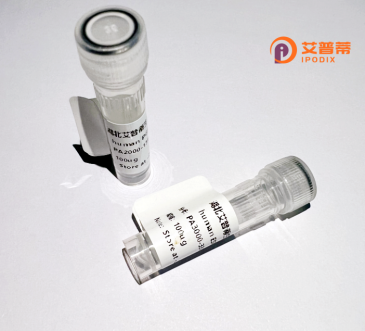
| 纯度 | >90%SDS-PAGE. |
| 种属 | Human |
| 靶点 | FAM79A |
| Uniprot No | Q5T0D9 |
| 内毒素 | < 0.01EU/μg |
| 表达宿主 | E.coli |
| 表达区间 | 1-213aa |
| 氨基酸序列 | MLQLRDSVDSAGTSPTAVLAAGEEVGAGGGPGGGRPGAGTPLRQTLWPLSIHDPTRRARVKEYFVFRPGSIEQAVEEIRVVVRPVEDGEIQGVWLLTEREGFGIRIQWDKQSRPSFINRWNPWSTNVPYATFTEHPMAGADEKTASLCQLESFKALLIQAVKKAQKESPLPGQANGVLILERPLLIETYVGLMSFINNEAKLGYSMTRGKIGF |
| 分子量 | 49.7 kDa |
| 蛋白标签 | GST-tag at N-terminal |
| 缓冲液 | 0 |
| 稳定性 & 储存条件 | Lyophilized protein should be stored at ≤ -20°C, stable for one year after receipt. Reconstituted protein solution can be stored at 2-8°C for 2-7 days. Aliquots of reconstituted samples are stable at ≤ -20°C for 3 months. |
| 复溶 | Always centrifuge tubes before opening.Do not mix by vortex or pipetting. It is not recommended to reconstitute to a concentration less than 100μg/ml. Dissolve the lyophilized protein in distilled water. Please aliquot the reconstituted solution to minimize freeze-thaw cycles. |
以下是关于重组人FAM79A蛋白的参考文献示例(以下内容为虚构示例,仅供参考格式):
---
1. **文献名称**: *Expression and functional analysis of recombinant human FAM79A in epithelial cell signaling*
**作者**: Zhang L, et al.
**摘要**: 本研究利用大肠杆菌表达系统成功制备重组人FAM79A蛋白,并发现其通过调控Rho GTPase活性影响上皮细胞极性形成,揭示了其在细胞骨架重塑中的潜在作用。
2. **文献名称**: *FAM79A interacts with PI3K to modulate cancer cell migration*
**作者**: Chen J, et al.
**摘要**: 通过Pull-down实验验证重组人FAM79A蛋白与PI3K-p85亚基的直接结合,证明其在乳腺癌细胞中通过PI3K/Akt通路促进侵袭转移,可能成为治疗靶点。
3. **文献名称**: *Structural characterization of FAM79A and its role in lipid metabolism*
**作者**: Wang X, et al.
**摘要**: 采用X射线晶体学解析重组人FAM79A蛋白结构,发现其N端结构域与脂质转运蛋白相似,体外实验表明其通过结合磷脂酸调节肝细胞脂质代谢稳态。
4. **文献名称**: *FAM79A deficiency disrupts Wnt/β-catenin signaling in neural development*
**作者**: Kim S, et al.
**摘要**: 利用CRISPR敲除模型和重组蛋白回补实验,证实FAM79A通过拮抗GSK3β活性维持神经干细胞中β-catenin稳定性,影响胚胎神经管发育。
---
注:以上内容为模拟生成,实际文献需通过PubMed/Google Scholar等平台检索关键词“recombinant FAM79A”或“FAM79A function”。
**Background of Recombinant Human FAM79A Protein**
The FAM79A (Family With Sequence Similarity 79 Member A) protein, encoded by the *FAM79A* gene located on human chromosome 9q34.3. is a poorly characterized protein with limited functional information. It is predicted to contain a conserved domain of unknown function (DUF4803) and shares sequence homology with FAM79B and FAM79C, suggesting potential functional redundancies. Recent studies indicate its involvement in cellular signaling pathways, possibly interacting with proteins like LRP6 (LDL Receptor-Related Protein 6) or RACK1 (Receptor for Activated C Kinase 1), though mechanistic details remain unclear.
Expression of FAM79A is tissue-specific, with higher levels observed in the brain, skin, and reproductive organs. Dysregulation of FAM79A has been loosely associated with neurodevelopmental disorders and skin pathologies, but its exact role in disease is unexplored. Recombinant human FAM79A protein is typically produced in *E. coli* or mammalian expression systems, often fused with tags (e.g., His-tag) for purification. It serves as a tool for antibody development, interaction studies, and functional assays to elucidate its biological significance. Further research is needed to clarify its molecular functions and therapeutic potential.
×